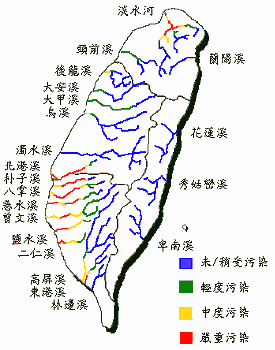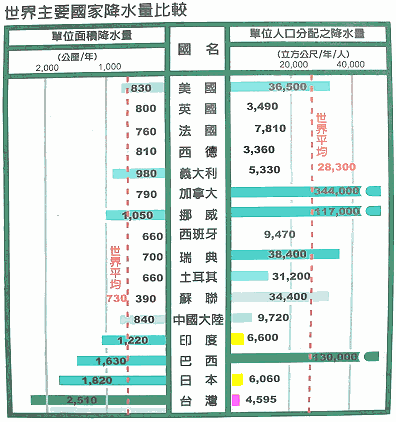In the data compiled by our team, Taiwan is the world's 18th-largest water scarcity country. In general, Taiwan has an average of more than 2000 millimeters of rain per year, which should be a country with no shortage of water resources, but because of the narrowness of the Taiwan region, steep slopes, heavy rains and short rivers, most of the rain is rapidly flowing into the ocean. Therefore, the average amount of water per person per year in Taiwan is only one-seventh of the world's average rainfall, which translates into an annual water consumption of about 1000 metric tons (1,000 cubic meters) per person, and in the current world standard of consumption, Taiwan is a country of scarcity (region).
Many people can't help asking: are we getting less water? According to the Central Meteorological Bureau's rainfall statistics, the annual rainfall is more or less variable, but the Long-run average change is not large. But the average person thinks that the water that can be used seems to be getting smaller, which is related to the following factors:
Environmental pollution problems
Taiwan has 21 major rivers, 29 secondary rivers and 79 ordinary rivers, in 2001, in the total length of 2,934 kilometers of the river, the unpolluted reaches 1808.88 km, the total length of the river 61.65%, the mild pollution reaches 287.62 km The moderate polluted reach is 451.30 km, which accounts for 15.38% of the total length of the river, and the severely polluted reach is 386.20 km, which accounts for 13.16% of the total length of the river. Statistical data over the years have shown that the number of unpolluted rivers is increasing, which means that the problem of river pollution is becoming more and more serious, resulting in the water quality of many rivers being unusable and the relative availability of water less.
Urbanization effect and excessive deforestation
Rainwater that is lowered in a plant's lush natural region is drained by runoff after the interception of the plant, and most of the rainwater that is dammed by the plant seeps underground into groundwater, which in the dry season seeps back the basic flow of the river. But the urban area expands with the population increase unceasingly, the concrete and the bitumen and so on impermeable water layer's area also unceasingly increases, as well as the slope land indiscriminate reclamation, the deforestation causes the surface runoff to increase, the groundwater recharge reduces, the result "rains then becomes floods, does not rain then becomes dry". The urbanization area also blocked the local water circulation path, caused the urban temperature rising "The heat island effect".
Changes in rainfall patterns
Because of the impact of global change, the original rainfall patterns have changed. The change of rainfall pattern can be divided into two aspects to explain: one is the change in time, that is, the original distribution in a whole year of rainfall, but concentrated in a very short period of time, such changes will not allow us to make effective use of water resources, even floods and droughts, the other is a change in space, That is to say, the rainwater in the reservoir catchment area, but below the reservoir downstream or at sea, so that I can not effectively intercept the use.
The above factors found that the climatic environment caused the availability of water is very scarce, so that agricultural production needs to take a large number of groundwater to irrigate.
Data source: Water resources problem in Taiwan

Pollution situation of Taiwan River

Comparison of precipitation in major countries of the world
Image source:Environmental Protection Department
Image source:Environmental Protection Department



